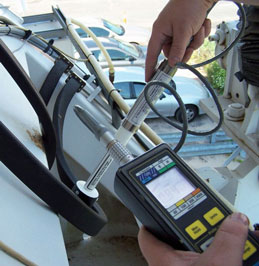RF Safety Measurements
 It is often necessary to make RF measurements to determine the magnitude of the RF fields at sites near antennas or in an area near certain types of manufacturing equipment that contains high-power RF generators. Although every situation is different, they can usually be categorized as one of the following:
It is often necessary to make RF measurements to determine the magnitude of the RF fields at sites near antennas or in an area near certain types of manufacturing equipment that contains high-power RF generators. Although every situation is different, they can usually be categorized as one of the following:
Checking for Leaks. Leaks can occur at waveguide junctions and anywhere along lengths of flexible waveguide. Leaks can also occur in various types of manufacturing equipment. For example, the shields in RF heat sealers or the seals in semiconductor processing equipment can be incorrectly attached after completion of maintenance activities. Checking for leaks is relatively simple providing the correct equipment is used. Maintenance personnel can learn to check for leaks as a part of their regular maintenance activities.
Complex Site Measurements. Measurements at complex, multi-emitter broadcast sites, especially near towers or chain-link fences where the RF energy can reflect off the metal can be difficult. Measurements at AM radio and HF communications sites can be especially challenging due to the interaction of the RF fields, the survey equipment, and the surveyor.
Where Measurements Are Not the Best Approach. Many wireless sites can be analyzed very accurately using sophisticated modeling software. A major advantage of the software is that a site can be analyzed under worst-case conditions with all systems operating at full power. The challenge with measuring wireless sites, such as rooftops, is that the RF environment is constantly changing. When you measure near a particular antenna and determine the field strength, there is no simple way to know whether the system is operating at full power or only a fraction of it. When you get no reading next to an omnidirectional whip antenna, it might be that the antenna is a receiving antenna. However, it could also be a transmitting antenna that is not active at the time you are trying to measure the fields near it. Of course, the major challenge with analyzing a site using computer-modeling techniques is to get the appropriate information concerning every transmitting antenna system at the site.
The other pages in this section of the Web site provide some guidance regarding equipment accuracy and calibration. There is also a page that explains shaped-frequency response, a design technique used in most RF personal monitors and many probes.
RF Safety Solutions can help you determine what equipment, if any, is right for you. We can train your personnel to not only understand RF safety issues, but to work safely in potentially hazardous RF environments. We can also train your personnel to comfortably conduct and document RF safety surveys.